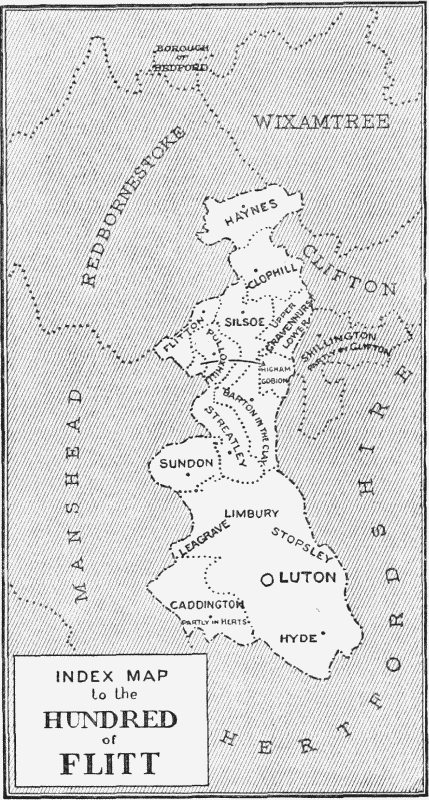A History of the County of Bedford: Volume 2. Originally published by Victoria County History, London, 1908.
This free content was digitised by double rekeying. All rights reserved.
'Flitt hundred: Introduction', in A History of the County of Bedford: Volume 2, (London, 1908) pp. 306-308. British History Online https://www.british-history.ac.uk/vch/beds/vol2/pp306-308 [accessed 11 April 2024]
THE HUNDRED OF FLITT
Containing the parishes of Barton; Caddington (Part of); Clophill; Flitton Cum Silsoe; Upper Gravenhurst; Lower Gravenhurst; Haynes; Higham Gobion; Luton, With East And West Hyde, Stopsley, Limbury Cum Biscott, And Leagrave; Pulloxhill; Streatley With Sharpenhoe; Sundon (fn. 1)
At the time of the Domesday Survey Flitt Hundred was assessed at 98 hides 12/3 virgates, and included all the places mentioned above with the exception of Luton, 30 hides in extent, which was royal property. (fn. 2) The greater part of Caddington, 10 hides in amount, was then included in Hertfordshire, while only five lay in Bedfordshire, but since 1897 the Hertfordshire portion has been transferred to Bedfordshire, (fn. 3) although for ecclesiastical purposes the parish is still divided between the two counties. Flitton cum Silsoe has been separated into two parishes since 1831, and Upper and Lower Gravenhurst were united in 1888. (fn. 4)
The hundred of Flitt followed to a certain extent the same descent as that of the manor of Luton, and it was held of the king in chief for the service of 60s. a year. In 1086 it was apparently attached to the manor of Luton, and was granted with it in 1229 to William Marshal, earl of Pembroke, on his marriage with the king's sister Eleanor, as her dower, but subjected to the yearly rent of 60s. (fn. 5) On the latter's death in 1274 the hundred passed to Isabel, wife of Reginald de Mohun, a daughter of Isabel de Clare, who was one of the co-heirs of the earl of Pembroke. (fn. 6) On the death of William de Mohun, their son, in 1282, the hundred was worth £10, and was inherited by his younger daughter Mary, wife of John de Meriet, after the death of her brother Reginald without issue. (fn. 7) Mary died childless, and on the death of her husband in 1327 the hundred was divided among her coheirs, (fn. 8) descendants of the daughters of Isabel de Clare, John de Bohun, John de Mohun, and Hugh de Mortimer, each of whom received a quarter, while the remaining quarter was divided between the other heirs, Henry Fitz Piers and John de Beauchamp. (fn. 9) By a series of settlements extending over twenty years, (fn. 10) Hugh de Mortimer acquired the whole hundred and died seised of it in 1372, (fn. 11) when it passed to his grandson William, an idiot, who died in 1391, leaving as his heir his brother Hugh, (fn. 12) who married Petronilla and died childless. On the latter's death in 1422 the hundred passed to John Cressy as cousin and heir of Hugh. (fn. 13) It then followed a similar descent to that of the manor of Luton, passing from the family of Cressy to the Wenlocks and afterwards to the Rotherhams; in 1612 it was sold by the Rotherhams to Lewis and Edward Marbury for £700, a preliminary step to alienating it to Richard and Robert Napier. The Marburys were ordered to appear in court but failed to put in an appearance, and the hundred was taken into the king's hand, but was finally restored to the Napiers in 1618. (fn. 14) It remained, with the manor of Luton, in the Napier family, passing from them to Francis Herne, a relative, who in 1764 alienated it to the earl of Bute; (fn. 15) the latter was holding the hundred in 1815, when the annual payment of 60s. was still made, (fn. 16) but after this date all rights in it seem to have lapsed.

Index Map to the Hundred of Flitt
In 1297 the hundred paid £38 15s. 4½d. towards a general subsidy, (fn. 17) while its contribution towards a general assessment had increased to £71 1s. 8¼d. in 1597; (fn. 18) in 1645 the amount rose further to £80 12s. (fn. 19)
Luton, as royal demesne, is not mentioned as situated in any hundred at the time of the Domesday Survey, but from the thirteenth century onwards, together with its hamlets of East and West Hyde, Limbury cum Biscott, and Stopsley, it formed a soke. (fn. 20) The hundred of Flitt, to which Luton would have owed suit, having become attached to the manor before 1229, this union of the manor and the hundred by its consequent merging of rights probably arrested the development of the soke along independent lines. In 1297, on the occasion of the levying of a ninth, Luton was assessed separately from the hundred; (fn. 21) whilst a taxation of 1523 gives the hamlets—whilst omitting Luton—as within the hundred. Subsequent to this latter date Luton is found as within the hundred of Flitt. (fn. 22)
The courts of the hundred were held every three years alternately at Silsoe and Luton, and up to a date as recent as fifty years ago the bailiff of the manor of Luton once a year fired a gun in front of the mansion of Wrest Park, Silsoe. This was done in assertion of some right claimed in respect of the hundred, and it was the custom for the bailiff to be invited into the house for refreshment. (fn. 23)
The parish of Shillington, which is situated partly in this hundred and partly in that of Clifton, will be found under the latter hundred.
